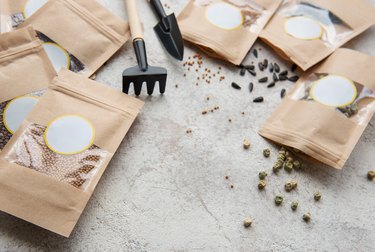
Plastic bags are the simplest kind of greenhouse. They're perfect for a home gardener, teacher or parent on a budget. Pre-sprouting seeds in plastic bags is not only a simple and effective method for starting seeds but it also allows for a perfect view of the germination process. Seeds can be grown directly inside the bag, or they can be placed in a planting medium and then covered with the bag.
Using Plastic Bags
Video of the Day
Growing seeds in a plastic bag for preschoolers is a fun and fascinating project for them and an easy way for you to demonstrate how seeds germinate. Sealed, clear plastic bags allow in sunlight but trap moisture, creating a warm, wet environment conducive to germination. They should only be used to start seeds, as the plastic will eventually become too hot for seedlings, which need air, to survive. Remove the plastic when the seedlings are tall enough to touch it or when they reach the opening of the bag.
Video of the Day
Pre-sprouting Seeds in Plastic Bags
To watch a seed sprout in a plastic bag, moisten a paper towel and then fold it in half or quarters depending on the size of the bag. Tuck the wet paper towel into the plastic bag, gently pushing it to the bottom of the bag. Then, slip the seed – two or three could be used depending on the size of the bag – between the moist paper towel and the side of the plastic bag.
Seal the top of the bag and then place it where it will be exposed to warm sunlight. Taping it to a vertical surface often works best but avoid taping it directly to a window, as windows can get too hot or even too cold for a growing seeds in a bag experiment.
Under-Bag Seed Germination
Fill seed pots, which usually come in tray form, with a soilless planting medium, such as one composed of peat and vermiculite. Water it, let it settle and add more medium until the pots are full. The medium should be moist but not soggy. Then, gently press one seed into each pot and cover the pots with a sealed plastic bag. To keep the plastic from touching the soil, insert wooden sticks along the outer edges of the tray to prop the bag.
Tips and Tricks
The trick to healthy germination when growing seeds in a baggie is keeping the root zone warm but not too cold or too hot. Resist the urge to place trays on windowsills, as cold drafts often come in under a window at night, and during the day it can get too hot. If your seeds require a period of darkness before being exposed to light, use dark plastic rather than translucent bags.
Hardening Off Your Seedlings
Your new baby plants are delicate and have not yet been exposed to outdoor conditions, so you'll have to get them used to the idea gradually after growing the seeds in a plastic bag. This is a process called hardening off, and it will keep your babies safe during the transition from indoors to outdoors.
Move the seedlings outdoors about two weeks before you plan to plant them outside. Pick a spot protected from the wind and leave them in the shade for several hours during the heat of the afternoon. Before the nighttime temperatures begin dropping, bring the seedlings back inside.
Put the seedlings back outside every day and leave them out a little longer each day. Gradually expose them to a little more direct sunshine. Unless freezing weather is in your forecast, after two weeks of hardening off, the seedlings can remain outside. Keep them in a sunny spot until you're ready to transplant them into their permanent spots.